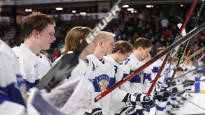At the NHL’s booking event, there was once again a thin Finnish supply, writes Urheilu’s NHL editor Tommi Seppälä.
Tommi Seppälä Urheilu’s NHL reporter
Three NHL booking events and two Finnish players booked in the first round. This is a cold fact for the previous three years. And they weren’t booked in the first round a year ago Joakim Kemell and Brad Lambert to be honest, not even close to the NHL world. For both of them, the expectation is not to be in the first basket at the NHL level.
Does Finnish ice hockey have cause for concern?
You could say that.
The domestic top at the NHL level is certainly tough, but it also seems to have created some kind of illusion about the current state of Finnish hockey together with the success in the prestigious competition. It is good to remember that Mikko Rantanen, Sebastian Aho, Roope Hintz, Alexander Barkov and Juuse Saros – to name a few – are reservations for the summers of 2015 and 2013.
Eight and ten years ago.
Since then, Finnish hockey has produced three players in the front line of the NHL: Patrik Laine, Miro Heiskanen and by Anton Lundell.
Huge numbers of Finns have been booked into the NHL in recent years, but many of these are, so to speak, second base players or farm players. The general public also often misses how many young Finnish players have difficulties even in the AHL world, the NHL’s development league.
For example, in 2020, 17 Finnish players were reserved for the NHL. Apart from Anton Lundell, no player has been able to even knock on the NHL door.
A year later, from the ones booked, it was only sold to Vancouver Morning on Rädy is a realistic NHL prospect right now in his career.
There is reason to be concerned about the trend.
It feels as if Finland has returned to the era of the beginning of the millennium. The years 2003–2008 in particular were a dark time for Finnish NHL hockey from the point of view of the young generation – Vierumäki produced only three-pointers in the NHL.
There is something similar in this time.
With the exception of a few exceptional individuals, Finland seems to produce players whose individual skills or skating are not sufficient for the world’s elite level. Often the matter is caught by both. Even now, the best Finnish players in the NHL are not products of a clear Finnish assembly line, rather each has followed his own path.
As a nation of less than six million people, Finland still produces good players, but at the same time one should be able to pick up a spoon in the first place. The dramatic decrease in the number of fans in the capital region, for example, would seem to be a huge concern for the Ice Hockey Federation when talking about player production.
You could also imagine that the blanks for some kind of big Vierumäki seminar are already in place.
Lajiväe should sit around a big table and think about how children and young people are coached in Finland today and how the gamblers of the future should be coached. It seems as if the entire Finnish hockey community follows their ideals as one sheep Jukka Jalonen After our game.
Our game deserves credit for the great years of Finnish national team hockey (2019–2022), but are we in the background, like in previous decades, trying to mold everyone into the same mold in the name of the common good.
Ice hockey is a team game, but without strong investments in individual skills and skating coaching, we will not be able to produce players in the best possible way for the top roles in the world, and thus also in the national team.
The results at different levels can already be seen, starting with the 18- and 20-year-old honors competitions and finally up to the men’s national team. In juniors, the medal pipelines are broken and in men, a generational change is ahead. It’s appropriate to ask how the next golden generation of the men’s national team will be built.
During a few golden years, Finnish hockey got drunk on its own excellence. Because of this, there is already a long way back. At the same time, the association should be able to meet challenges not only at the societal level but also within the sport. Children’s immobility and the unbearable cost of hockey are big challenges for our country’s number one sport.
When, at the same time, the Ice Hockey Association suffers from a huge leadership deficit, it’s no big wonder that the whole ship seems to be in the wind. Who has a vision of where the absolute top level of hockey is going and a vision of how Finnish hockey can best prepare its own young players for that demanding level?
Right now, apparently not for anyone, because no exits of any kind have been seen in a while.
This chaos can also be seen in the NHL’s booking events, where Finns have already seen several lean years.
You can discuss the topic on 30.6. until 11 p.m. Tunnus is required for commenting.
